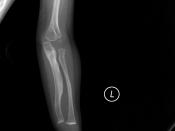Osteogenesis imperfecta
Osteogenesis imperfecta (OI) is a genetic disorder characterized by bones that break easily, often from little or no apparent cause. There are at least four recognized forms of the disorder, representing extreme variation in severity from one individual to another. For example, a person may have just a few or as many as several hundred fractures in a lifetime (OI foundation).
OI is caused by a genetic defect that affects the body's production of collagen. It is a defect in either of the two genes that code for collagen I, called COL1A1 on chromosome 17, or COL1A2 on chromosome 7. (OIFE) Collagen is the major protein of the body's connective tissue and can be likened to the framework around which a building is constructed. In OI, a person has either less collagen than normal, or a poorer quality of collagen than normal that leads to weak bones that fracture easily (Smith).
It is often, though not always, possible to diagnose OI based solely on clinical features. Clinical geneticists can also perform biochemical, collagen, or molecular, DNA tests that can help confirm a diagnosis of OI in some situations.
The signs and symptoms of OI vary greatly depending on the type. There are 4 main types: Type I, Type II, Type III, and Type IV.
Type I is the most common and mildest type of OI. The bones predisposed to fracture. Most fractures occur before puberty. People with it have normal or near-normal stature. They have loose joints and low muscle tone. The sclera, which is the whites of the eyes, usually have a blue, purple, or gray tint. They have a triangular face. Their spine tends to have a slight curvature. Bone deformity is absent or minimal. It is possible to have brittle teeth. Hearing loss is...


